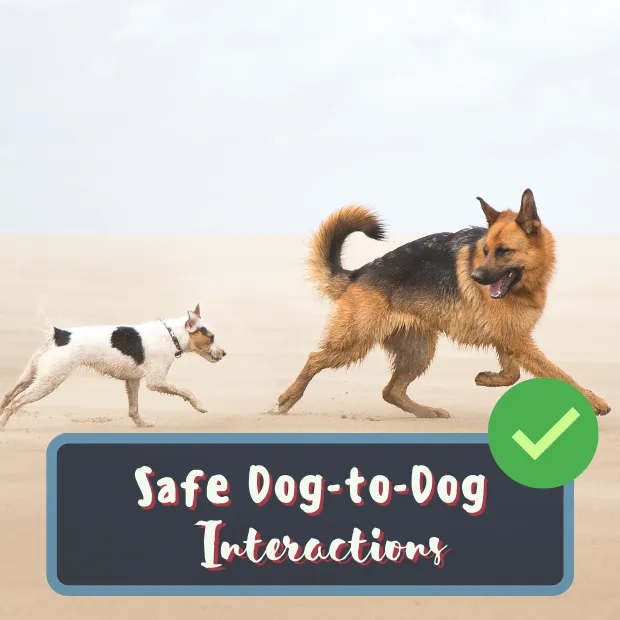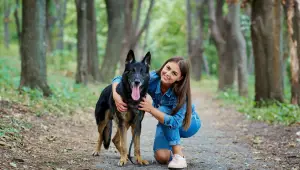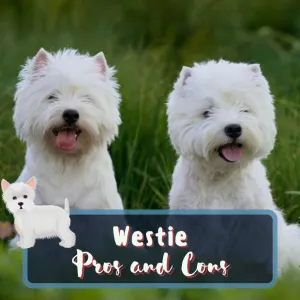Dogs are social animals and love interacting with other dogs. But it’s important to make sure that their interactions are safe, especially if they’re not familiar with each other.
Here are some tips for ensuring safe dog-to-dog interactions.
Table of Contents
ToggleContents of this article:
- What are safe dog-to-dog interactions?
- How do dogs greet each other?
- Introducing new dogs to one another.
- On leash or off leash?
- What does good dog play look like?
- Summary – dogs playing together
What are safe dog-to-dog interactions?
A good dog interaction is one in which both dogs are relaxed and comfortable. They should be able to approach each other without feeling anxious or threatened, and they should be able to sniff and explore each other without resulting in a fight.
In addition, both dogs should be able to walk away from the interaction without feeling scared or nervous. Ideally, a good dog interaction will result in the dogs becoming friends, but even if they don’t become best buddies, it should still be a positive experience for both dogs.
When two dogs are playing together nicely, ideally you will see them taking turns. This means they are both enjoying themselves and feel comfortable around each other.
Dogs that stare at one another or jump on one another are not having a good time. If one dog is constantly chasing the other without giving them a chance to turn around and chase, this indicates an issue.
This is unfair play. One dog is being bullied by the other. It is a sign that one dog is uncomfortable and may have to escalate to get the other dog to stop, which could cause a fight.
You should always be able to see daylight between two dogs that are wrestling. This is how you can tell they are not pinning the other down.
How do dogs greet each other?
Dogs have a unique way of greeting each other that often involves a lot of sniffing. When dogs meet each other for the first time, they usually start by sniffing each other’s faces and then sniffing their behinds. This may seem like an odd way to greet someone, but it’s actually quite important.
Dogs have two glands on their behinds that secrete pheromones, and by sniffing each other’s rear ends, they can get a better sense of who the other dog is.
It gives them information about the dog’s health, age, and gender, and it also helps dogs to individualize each other and to determine whether they are potential mates.
This is especially important when dogs are meeting for the first time, as it helps them to size each other up and decide whether or not they want to be friends.
Introducing new dogs to one another.
Introducing new dogs to one another can be a daunting task, but it’s important to get it right in order to ensure a smooth transition for both animals. Here are a few tips to help make the process as easy as possible.
Neutral territory.
Dogs meeting other dogs can often be a tricky experience. When introducing two or more dogs for the first time, always do it in a neutral territory.
Many dogs can be territorial about their home or garden, so it’s important to make sure they’re meeting in a place where neither of them feels like they’re on their own turf.
Parallel walking.
When dogs meet for the first time, it’s important to make sure that the introduction goes smoothly. One way to do this is by parallel walking. This means walking your dog alongside another dog, keeping them at a comfortable distance from each other.
This will allow them to see and smell each other without feeling threatened or overwhelmed. If both dogs seem relaxed and happy, you can then allow them to approach each other and greet each other more formally.
However, if either dog seems uncomfortable, it’s best to keep them apart and try again another time. By taking things slowly and being cautious, you can help ensure that your dogs have a positive experience when meeting new friends.
Engage/disengage game.
Dogs meeting other dogs can be extremely exciting, or it can be a complete disaster. In order to make sure that your dogs have a positive experience when meeting other dogs, it is important to play a game of engage/disengage, also known as Look at That (LAT).
This game is simple – you stay at a distance from the other dog and when your dog looks towards them, say “Good” and give them a reward. This creates a positive association with the other dog without your dog becoming fixated on them.
Gradually decrease the distance at which you play the game.
On leash or off leash?
Many of my clients’ dogs meet up with other dogs when they are out walking in their community. While this may seem like a good thing, it’s not always the case.
Having a one-on-one situation is good because it will not be overwhelming as it can be at a day care or dog park. But it can be tricky for dogs to interact in a meaningful way if they are on leashes. This is especially true if the dogs don’t know each other.
Meeting on leashes might be okay if the dogs are already friends, but it is usually better to let them meet without leashes so they can properly display and read each other’s canine body language whilst getting to know each other better.
If a dog feels overwhelmed, their two main options are to fight or to run away (the “fight or flight” response). When a dog is on a leash, they can’t run away or add distance if they need to.
That only leaves them with the fight option of “fight or flight”, even if they don’t want to. The tension of on-leash greetings often causes dogs too much stress, resulting in a fight and when leashes get tangled, it’s difficult to separate the dogs.
If you can’t avoid an on-leash greeting, keep it to less than three seconds so that neither dog becomes overwhelmed and move them along before there’s an opportunity for tension to creep in to the interaction.
What does good dog play look like?
We often think of dog play as just dogs running around and playing together. But in reality, it’s actually practice for them hunting and if you watch closely, you can see glimpses of this in their behavior.
Good dog play should be:
· Social – both dogs should be happy and enjoy themselves
· Well-matched – the play shouldn’t be too one-sided
· Safe – no biting or fighting should take place
If you’re not sure if your dogs are playing nicely together, it’s always best to err on the side of caution and separate them. You can always try again another time when you can keep a closer eye on things.
Fortunately, most dogs have a wonderful time playing. We want our pets to be safe whilst enjoying the exercise benefits that playing provides.
Low risk – no cause for concern.
Dogs that play together can get a lot of beneficial aerobic exercise. Play is safe when you observe these signals:
- A curved approach towards one another,
- Turn taking,
- Pauses in play,
- Relaxed, loose, wiggly interactions.
When two dogs approach each other, they should approach each other in an arc, so their bodies are curved. If there is eye contact this should be soft, and their tails should be relaxed, with a broad sweeping motion. This shows that they are interested in each other.
Both dogs’ bodies should also appear calm and relaxed, with no tension visible. If the dogs appear to be mirroring one another’s body language or activity level, it’s a good sign that they’re comfortable in each other’s company.
When one dog has initiated a break from play, the other should give them some space before playing recommences, rather than use it as an opportunity to ambush them! This is an important part of good interactions.
If you see any of these signs, the dogs are likely to be playing nicely together.
Medium risk – keep an eye on things.
These interactions aren’t necessarily problematic, but they could escalate if not managed carefully:
- Mouthing or nipping,
- Wrestling,
- Tackling from behind.
“Mouthing” is when a dog puts their mouth on another dog’s body, but without using any pressure. It’s often seen as a way of initiating play. If the mouthing is relaxed and gentle, and both dogs seem happy, then it’s probably fine. But if the mouthing is hard or one dog appears to be uncomfortable, then it’s best to intervene.
“Nipping” is when a dog uses their teeth in a more forceful way and this could cause injury. Nipping should always be discouraged, as it can lead to fighting.
Wrestling and tackling from behind can also escalate into fighting, so it’s best to keep an eye on these activities and intervene if necessary.
Dogs are social creatures, and they often enjoy interacting with other dogs. However, sometimes these interactions can take a turn for the worse. Often, this is because one or both dogs are too aroused.
When a dog is over an excitement threshold – for any reason – he cannot respond appropriately to the situation. This can lead to aggression, fighting, and even bites.
A well-timed recall can be an effective way to defuse a heated situation. By calling your dog back to you, you can help to break the cycle of arousal and allow both dogs to calm down.
In addition, it is important to be mindful of your own dog’s arousal levels. If he is feeling stressed or anxious, he may be more likely to react poorly to another dog.
By keeping an eye on your dog’s body language and monitoring his interactions with other dogs, you can help to prevent problems before they start.
High risk – stop the behaviour immediately.
The following interactions are highly likely to lead to a fight:
- Staring – Hard staring or a “hard eye” is often seen as a challenge. It can be considered threatening behaviour and is best avoided.
- Intense play – Play that is too rough or too one-sided can lead to fighting. If one dog is consistently tackling the other, it’s best to intervene. If there are no pauses in play, it may be best to terminate the interaction.
- Another sign is body weight forward and stiff body language, which shows that the dog is ready to lunge forward.
- Finally, if a dog is showing teeth while barking or targeting another dog, this is a clear sign things are getting out of hand and you should intervene. If any of these signs are present, it is best to end the interaction between dogs for the safety of everyone involved.
Remember, dogs don’t need to be physically hurt in order for them to become reactive or aggressive. Any type of arousal, if not properly managed, can lead to a fight that could traumatize either dog to a point where even the sight of another dog could trigger an over-reaction.
When in doubt, it is always best to err on the side of caution. If you are unsure whether an interaction is safe, it is best to intervene or end the interaction altogether. It is always better to be safe than sorry when it comes to managing dog-to-dog interactions.
Summary – safe dog interactions.
Dogs playing together can be a great way for them to burn off energy, get some exercise, and have fun. However, it’s important to make sure that they are playing safely. Dogs who are meeting for the first time may not know each other’s boundaries, and rough play can quickly turn into a fight.
If you see any signs that play is not fair or too intense, intervene immediately and separate the dogs. Once they’ve had a chance to calm down, you can try reintroducing them again. With supervision and a little patience, most dogs will be able to enjoy playing together safely.
Now that you know what to look for, you can enjoy watching your dogs play together safe in the knowledge that they’re having a good time.
References: https://www.dogstrust.org.uk/help-advice/behaviour/how-dogs-communicate-with-each-other







